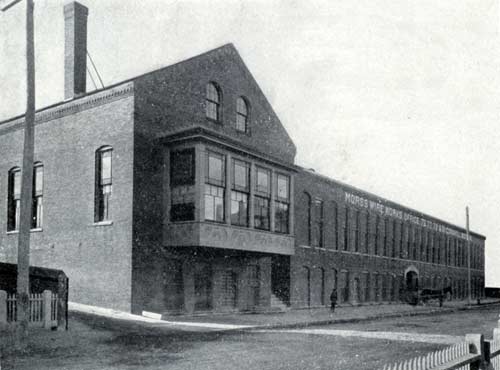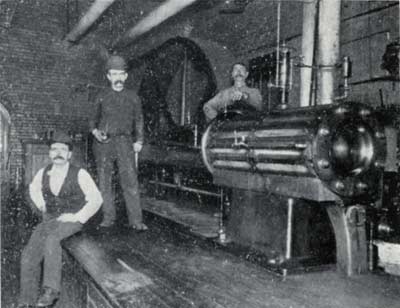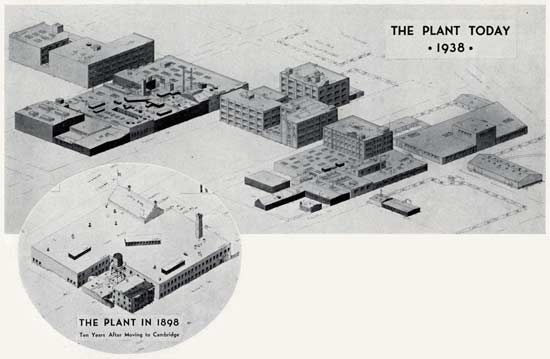Fifty Years of Steady Progress at Simplex Shows Large Growth of Plant and Equipment
Production stepped up from twenty miles to millions of feet per day
Simplex has been in Cambridge almost exactly fifty years but Simplex wire dates back to the spring of 1885 when Morss & Whyte started the manufacture of Campbell Anti-Induction Telephone Wire and weatherproof wire in their factory at Cottage Farm where the Noyes-Buick building now stands.
The Anti-Induction Wire never developed into a business but the first commercial weatherproof wire was turned out in December 1885 and by 1888 had developed into a production of about twenty miles a week, the principal sizes being #4, 6, and 8 B. & S. The first mile of wire sold was installed on St. Paul Street, Boston, between Commonwealth Avenue and Beacon Street.
In their factory at Cottage Farm, Morss & Whyte had four distinct manufacturing departments.
1. Wire railing business which was later sold to Swett & Sibley.
2. Wire dress form business which lasted until about 1892.
3. Manufacture of knit goods. This had previously been known as the Allston Mills and was taken over by Morss & Whyte. January 1, 1888. It was unprofitable and abandoned about November 1, 1888.
4. Manufacture of braided, weatherproof line wire known as T. Z. R. wire. This was the forerunner of our present wire and cable business.
On the Saturday evening before Thanksgiving, just fifty years ago, the Cottage Farm factory was totally destroyed by fire. By the next Saturday night Morss & Whyte had bought the cracker factory of the Wilson Cass Co., consisting of our present buildings 1, 3, 4 and 5 and including land, buildings, engine, boiler plant and line shafting.
Mr. Cass and Frank A. Kennedy had been partners in the Kennedy Biscuit Co., which was later to become a part of the National Biscuit Company. They separated about 1885 and Cass built a new factory across the street from Kennedy. The new business was not successful and by 1888 the plant was idle and Cass was out of business.
The Wilson Cass Co. also owned a stable located on the land where building #11 now stands and this was purchased shortly after coming to Cambridge. The stable was renovated and occupied by the Simplex Electric Heating Co. for a number of years. At about this same time we also purchased the land on which building #2 now stands.
When purchased, building #1 was filled with cracker machinery including five great brick ovens which extended from their foundations underground almost to the roof, all of which had to be cleared away before installation of machinery could be started. The second floor of building #1 was of wood which was not entirely replaced by concrete until 1929. The first story of building #1 was a basement with no floor over the dirt which was about one foot above the present floor level.

Factory office and plant about 50 years ago (Franklin Street side) |
The wire railing business was located on the Auburn Street side of the second floor, with a blacksmith shop in the basement below. The wire dress form business was located on the second floor of building # 1 where the cable braiders now stand. The T. Z. R. weatherproof wire business was on the second floor in that end of the building which adjoins what is now our building #30. Here sufficient braiders were installed to produce about twenty miles of wire a week but during 1889 more braiders were added to bring production up to about sixty miles per week.
The power plant was in building #3 and consisted of a 66" fire tube boiler located about where the Auburn Street driveway now is. It furnished steam for an 80 horsepower engine. A belt from the flywheel of this engine passed through the wall to a shaft in what is now our mill room and from the shaft all power was distributed. In 1891 a 72" fire tube boiler was installed which was the first addition to the original power plant. The machine shop was on the second floor of building #3 where it remained until 1926 when it was moved to its present location.

1888 Power Plant and crew.
The late John E. Whitten (posed in center) was the “boss.” |
Building #4 had its present roof but the second floor was three feet or more below the level of the second floor of building #1. The second floor of building #4 was reached by two inclined driveways, one coming up from Franklin Street and the other coming up from Auburn Street.
About 1897 the inclined driveway to Auburn Street was taken out and a two story building with plaster walls was erected in its place. Not only was this the shipping room for building #1 but coal was hauled up the incline and dropped through scuttles into the cellar below. The wall of building #4 on the easterly side was of wood for about six feet above the floor. The balance of this wall all the way to the roof was filled in with glass sash. On account of the peculiar construction it was called the "Conservatory."
Building #5 was the office building of the cracker factory and was two stories high with a pitched roof. The entrance was from Franklin Street at the top of a long flight of stone steps. These offices were occupied by Morss & Whyte and the Simplex Co. until 1903 when new offices were constructed in building #6.
Sometime in 1889 a plank floor was laid in the basement of building #1 after sufficient dirt had been removed to bring it down to about its present level. The wire railing business was transferred to the Franklin Street side of this new area and the manufacture of wire having rubber insulation was started in the Auburn Street area now occupied by our mill room.
It is from this small beginning in Cambridge about fifty years ago that our present Simplex Wire & Cable Company business has grown. A new building was added every few years from 1899 to 1929, since which we have gradually occupied buildings 8, 9, 10 and 11, which were left vacant when the Simplex Electric Heating Company was sold. Another new building is now being added to our Tirex plant on Pacific Street and is the first new construction job since 1929.
In 1888 we were equipped to produce about twenty miles of braided weatherproof wire per week. Today our present plant can easily turn out millions of feet of rubber covered wire per day. The weatherproof wire which was manufactured in large quantities immediately after coming to Cambridge is no longer a Simplex product, having been superseded by our present extensive line of wires and cables insulated with rubber, paper and cambric.

|
The Plant in 1898
Ten Years After Moving to Cambridge |
The Plant Today
1938 |

